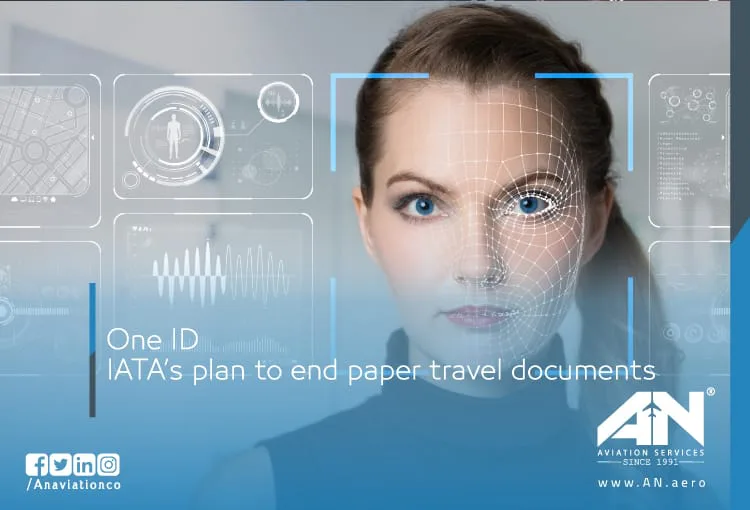
In an age where technology is streamlining nearly every aspect of life, the aviation industry is making significant strides toward eliminating paper-based processes. The International Air Transport Association (IATA) has launched an ambitious initiative called One ID, aiming to redefine the way passengers travel by phasing out traditional paper travel documents. But what exactly is One ID, and how will it transform the air travel experience? Let’s explore this forward-thinking approach and its implications for passengers, airlines, and the global aviation industry.
What Is One ID?
One ID is a global initiative spearheaded by IATA that envisions a paperless and seamless air travel experience. Instead of relying on physical documents such as passports, boarding passes, and paper tickets, One ID focuses on utilizing biometric technology to verify passengers’ identities.
This initiative aims to create a “single token” system where a traveler’s biometric data—such as facial recognition, iris scans, or fingerprints—becomes the key to navigating the entire airport journey. From check-in to boarding, passengers can glide through various checkpoints without the need to fumble with documents or tickets.
At its core, One ID prioritizes simplicity, speed, and security while enhancing the overall passenger experience.
Why Is One ID Necessary?
The air travel ecosystem has grown increasingly complex in recent decades. With rising passenger numbers, airports and airlines are under pressure to improve efficiency without compromising security. Traditional paper-based systems are no longer sustainable in the face of growing demands for speed and convenience.
1. Improving Passenger Experience:
One of the primary drivers of the One ID initiative is to reduce bottlenecks at airports. Long queues at security checkpoints and boarding gates can frustrate passengers and slow down operations. A biometric-driven system offers a faster and smoother alternative, helping passengers save time and avoid unnecessary stress.
2. Enhanced Security Measures:
One ID also bolsters security by ensuring that passengers’ identities are verified using biometric technology, which is harder to forge than traditional paper documents. With each checkpoint securely linked to biometric data, the risk of identity theft or document fraud decreases significantly.
3. Sustainability Goals:
The move toward a paperless travel ecosystem aligns with broader global efforts to reduce environmental waste. By eliminating paper tickets, boarding passes, and other travel documents, the aviation industry can contribute to reducing its carbon footprint.
How Does One ID Work?
The One ID framework revolves around a three-step process:
Enrollment:
Travelers provide their biometric data (such as facial scans or fingerprints) at the time of booking or before arriving at the airport. This information is securely linked to their travel credentials, such as passports and tickets.
Seamless Identification:
Upon arriving at the airport, passengers’ identities are verified at each checkpoint using biometric recognition. Instead of showing a passport or boarding pass, travelers simply scan their faces or fingerprints at designated kiosks.
Journey Completion:
From check-in to boarding, the system uses biometric data as the single token of identification, creating a seamless end-to-end experience.
Benefits of One ID for Passengers
The One ID initiative offers numerous advantages for travelers:
- Speed and Efficiency: The use of biometrics eliminates the need to repeatedly present paper documents at every stage of the journey, significantly reducing wait times.
- Personalized Experience: By linking biometric data to travel information, passengers may receive personalized services, such as tailored flight updates or assistance.
- Reduced Stress: Traveling without the worry of losing tickets or passports makes the journey more convenient.
- Sustainability: A paperless approach reduces the reliance on physical resources, contributing to environmentally conscious travel.
Benefits of One ID for Airlines and Airports
While passengers stand to gain, airlines and airports also benefit significantly from the adoption of One ID:
- Operational Efficiency: Automated biometric systems reduce manual labor and speed up passenger processing.
- Enhanced Security: Advanced biometric verification minimizes the risk of human error or document fraud.
- Cost Savings: Eliminating paper documents and reducing processing times can result in significant savings for airlines and airport operators.
- Scalability: As passenger numbers grow, One ID systems can easily adapt to increased demand without straining existing infrastructure.
Privacy and Security Concerns
Despite its numerous advantages, the One ID initiative has faced questions regarding data privacy and security. Travelers often wonder:
Who Controls My Data?
IATA emphasizes that biometric data will only be used for travel purposes and stored securely in compliance with international data protection laws. Passengers’ consent will be required before their information is collected.
Can My Data Be Misused?
One ID systems are designed with robust encryption and security protocols to prevent unauthorized access. Any breaches are addressed swiftly through advanced cybersecurity measures.
What About Non-Tech-Savvy Travelers?
IATA acknowledges that not all travelers may be comfortable with biometric technology. To address this, traditional check-in and boarding processes will remain available as an alternative.
The Future of One ID
IATA’s One ID is already being tested at select airports around the world. Cities like Singapore, Doha, and London have embraced biometric technology to streamline passenger journeys. As more airports and airlines adopt the initiative, One ID has the potential to become the global standard for air travel.
Beyond passenger processing, the technology could extend to areas such as baggage tracking, lounge access, and even in-flight purchases. The ultimate goal is to create a fully connected, paperless ecosystem that benefits both travelers and the aviation industry as a whole.
Conclusion
The One ID initiative represents a monumental step toward transforming the air travel experience. By replacing paper travel documents with biometric data, passengers can look forward to faster, more secure, and environmentally friendly journeys.
While challenges such as privacy concerns and implementation costs remain, the potential benefits far outweigh the hurdles. One ID is not just about convenience—it’s about redefining the way we travel, making it safer, smarter, and more sustainable. With IATA’s vision for the future, the dream of seamless, paperless travel is quickly becoming a reality.

